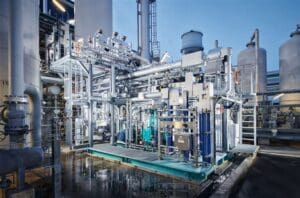
Canada has grown to become the fourth-largest oil producer and exporter in the world, reaching all-time high production of 5.558 million barrels per day (bpd) in 2021. In addition to its oil industry, Canada has several planned and proposed liquefied natural gas (LNG) projects. Canada has higher oil and gas production per capita than the United States. Despite its heavy reliance on fossil fuels, the country has been adamant about hydrogen investments, carbon capture and storage (CCS), and other alternative fuels.
Canada’s hydrogen ambitions took a leap forward in late August when Canada and Germany signed a joint declaration of intent focused on the export of Canadian hydrogen to Germany. Known as the Canada-Germany Hydrogen Alliance, the goal is to align policy, develop secure supply chains, and open a transatlantic Canada-Germany supply corridor that will set the stage for the export of clean hydrogen by 2025. “As Russia continues to weaponize energy in its illegal war with Ukraine, Canada is working with European partners to strengthen global energy security and accelerate the global clean energy transition,” said the Canadian Government in a statement. “To these ends, Canada’s allies in Europe have initiated efforts to displace imports of Russian oil and gas in the short term while accelerating efforts to deploy renewable energy and clean hydrogen. The Government of Canada is committed to supporting these efforts.”
An Alliance Is Born
The Canada-Germany Hydrogen Alliance is a follow up to the March 2021 memorandum of understanding (MoU) between Canada and Germany that aligned both countries in energy policy, planning, regulations, development of clean and affordable electricity systems, energy efficiency, sector coupling with low-carbon fuels, innovation, and applied research. The Canada-Germany Hydrogen Alliance takes the cooperation a step further by expanding the scope of energy security and by building independent and direct supply chains that will make the transfer of hydrogen reliable. “This declaration sends a clear signal to the private sector and to sub-national leaders in both countries that Canada and Germany are committed to a policy and regulatory environment that will facilitate and encourage investment in the hydrogen value chain in both countries,” said the Canadian Government in a statement.
“Unlocking the potential of hydrogen is an essential part of our government’s plan for a sustainable economic future — not just for the domestic opportunities for emissions reductions but also for its potential as an export opportunity: to provide clean energy to countries around the globe,” said Canada’s Minister of Natural Resources Jonathan Wilkinson.
“Green hydrogen is an important key for a climate-neutral economy,” said Federal Minister For Economic Affairs and Climate Action and Vice Chancellor of Germany Robert Habeck. “We must resolutely pursue climate change mitigation to secure our prosperity and freedom. This is more important and urgent than ever. The Hydrogen Alliance between Canada and Germany is a significant milestone as we accelerate the international market rollout of green hydrogen and clear the way for new transatlantic cooperation. Specifically, we aim to build up a transatlantic supply chain for green hydrogen. The first shipments from Canada to Germany are to begin as early as 2025.”
Advancing The Global Hydrogen Economy
The agreement falls in line with both country’s individual hydrogen goals. Germany and Canada are guiding for carbon neutrality by 2050, with hydrogen playing a key role in utilizing existing infrastructure to decarbonize industry. Germany is the largest investor in hydrogen of any country in the world. In its 2020 National Hydrogen Strategy report, Germany said that its “Federal Government expects that around 90 to 110 TWh of hydrogen will be needed by 2030. To cover part of this demand, Germany plans to establish up to 5 GW of generation capacity including the offshore and onshore energy generation facilities needed. This corresponds to 14 TWh of green hydrogen production and will require 20 TWh of renewables-based electricity. It needs to be ensured that the demand for electricity that is created by the electrolyzers will not lead to an increase in carbon emissions. The Federal Government has included a monitoring mechanism in the National Hydrogen Strategy which will be used to track the development of green hydrogen demand in detail. An additional 5 GW of capacity are to be added, if possible, by 2035 and no later than 2040. However, the domestic generation of green hydrogen will not be sufficient to cover all new demand, which is why most of the hydrogen needed will have to be imported.”
Germany’s federal funding is going toward investments in fuel cell technology, building hydrogen charging stations, basic research on green hydrogen, energy research on hydrogen technology, investments to support the transfer of ideas to real world applications, and more than US$1 billion between 2020 and 2023 for decarbonizing manufacturing processes for large-scale industrial facilities. “A considerable increase in the demand for hydrogen is expected in the medium to long term. To harness the full potential of hydrogen technology, the next steps need to be taken to speed up the rollout of this technology together with the private sector,” Germany said in its 2020 National Hydrogen Strategy report. “The National Hydrogen Strategy provides the basis for private-sector investment in hydrogen generation that is both economically viable and sustainable, and in its transport and use. Considering the status quo, it is unlikely that the large quantities of hydrogen that will be needed for the energy transition can be produced in Germany alone, as Germany’s renewable energy generation capacity is limited. This means that Germany will continue to import much of its energy from abroad. We will foster and intensify international cooperation and partnerships on hydrogen.”
Hydrogen’s Role In The Canadian Economy
Over the past two years, Canada has released two major energy reports in response to green policy developments. In December 2020, the Hydrogen Strategy For Canada detailed the ways in which Canada is going to transform its domestic economy and create more than 350,000 green jobs by 2050. In March 2022 (updated in July 2022), Canada released its 2030 Emissions Reduction Plan: Canada’s Next Steps for Clean Air And A Strong Economy (2030 Emissions Reduction Plan) which will lead the country toward 40% emissions reductions relative to 2005 levels by 2030 and net-zero emissions by 2050.
Just as Germany is well positioned to be the world’s largest consumer of hydrogen in the decades to come, Canada could very well grow to become the world’s largest exporter of green hydrogen. Domestically, Canada forecasts that clean hydrogen could make up 30% of its end-use energy by 2050, which translates to around 190 MT of carbon dioxide equivalent (MTCO2e) of abated greenhouse gas (GHG) emissions. Canada believes that hydrogen’s main impact will be through transportation, heating, and industrial applications. By 2050, Canada expects hydrogen demand to be 20 MT. By 2030, hydrogen could make up 6% of Canada’s end-use energy, with hydrogen demand of 4 MT and GHG emissions abated of up to 45 MTCO2e.

Canada’s goals may look lofty. But they are supported by several advantages that few other countries, let alone energy exporting countries, can compete with. According to the Hydrogen Strategy For Canada, “Canada has among the lowest carbon intensity electricity supplies in the world given its hydroelectric generation capacity and status as a Tier-1 nuclear region. Canada also has abundant fossil fuel reserves, world class CO2 storage geology, potential for growth in variable renewables, large-scale biomass supply, and freshwater resources. All of these can be leveraged to produce hydrogen.” Canada has been heavily investing in hydrogen and CCS for more than a decade and has some of the most sophisticated CCS projects in the world. The country also has a large energy sector and a skilled labor force that can be used for hydrogen production. Canada’s natural gas pipeline network and associated storage, compression, and distribution assets can be used to transport hydrogen safely and securely throughout the region. Fossil fuel reserves paired with carbon storage, renewable energy, biomass supply, freshwater resources, and plenty of inexpensive resources and land make Canada’s hydrogen production targets achievable. The Canadian government is also widely pro-hydrogen, which should lead to decades of low resistance when it comes to rapid federal support for hydrogen development. Canada also has existing export relationships with the world’s largest energy importers, deep water ports, pipelines, and other infrastructure capable of serving a growing list of global buyers. “Canada is recognized as a global leader in the hydrogen and fuel cell sector, seen as a hub for technical expertise, intellectual property, and leading products and services,” said the Hydrogen Strategy For Canada. “Canada is one of the top 10 hydrogen producers in the world today. An estimated 3 MT are produced per year from natural gas. Canada is home to the largest clean hydrogen production facility in the world to produce hydrogen from natural gas with carbon capture and permanent storage for the resulting CO2 emissions.”
Canada believes that hydrogen investments will lead to economic growth, jobs, a transformation of its petroleum sector in a way that benefits existing workers and unlocks the full potential of its talent pool, boosts Canada’s energy independence, leads to cleaner air, and helps the country reach its broader climate goals.
As impressive as Canada’s hydrogen profile is, leadership commentary on hydrogen often involves a tone of pressure and a hint of anxiety to ramp investment so Canada doesn’t miss what is likely to be a multi-decade growth opportunity. In the short term, Canada can use hydrogen to decarbonize existing natural gas networks by blending low-carbon hydrogen with natural gas. Hydrogen can also be used as a feedstock in industrial processes such as steel manufacturing. Ongoing investments in hydrogen and fuel cell technology aim to put hydrogen-powered vehicles on the road and reduce transportation industry emissions.
In the Hydrogen Strategy For Canada, the country laid out a multi-step approach meant to overcome challenges related to economics, innovation, policies, codes and standards, and availability. It all starts with developing strategic partnerships (like the agreement with Germany) to develop technologies but also identify end markets so hydrogen investments won’t drain Canada’s federal budget. Canada is also establishing funding programs and policies to make the hydrogen economy attractive to the private sector and avoid barriers to entry. Ultimately, the goal is to support innovation and raise awareness for hydrogen as a reliable and clean energy source.
Hydrogen’s Economic Impact In Canada
As mentioned, the Hydrogen Strategy For Canada sees hydrogen making up 6% of Canada’s end energy use by 2030 and up to 30% by 2050. What’s unique about clean hydrogen is that it is one of the few investment opportunities that relates to almost every subcategory of Canada’s US$7 billion 2030 Emissions Reductions Plan. The largest line item from the plan is US$2.2 billion toward investments in zero-emissions vehicles (ZEVs), which includes charging investments in hydrogen-powered vehicles as well as electric vehicles (EVs). Hydrogen filling stations can require dozens of high-pressure storage tanks, multiple hydrogen compressors, and fuel pumps. Like California, Canada plans to have ZEVs make up 100% of new passenger vehicles sales by 2035. However, Canada also aims to have ZEVs make up 20% of new passenger vehicle sales by 2026 and 60% by 2030.
“Taking real climate action that is not only ambitious, but also achievable, is key to building a strong economy in the 21st century,” said Prime Minster of Canada Justin Trudeau during the announcement of the 2030 Emissions Reductions Plan. “We are continuing to deliver on the priorities Canadians asked us to address — clean air, good jobs, a strong economy, and a better future for everyone.”

Hydrogen can also play a role in the US$770 million investments toward Canada’s net-zero by 2050 building plan, which is part of the Canada Green Buildings Strategy. Canada’s 2030 Emissions Reductions Plan Involves federal support for industrial adoption of green hydrogen and US$650 million toward decarbonizing Canada’s electricity grid, which aims to be net-zero by 2035.
The hydrogen industry offers a key growth driver for Canada’s oil and gas industry. However, it’s worth mentioning that Canada doesn’t just want its oil and gas industry to embrace hydrogen, it is somewhat forcing it through emissions caps. “We will continue working closely with provinces and territories, stakeholders, and Indigenous partners to develop an approach to cap oil and gas sector emissions to achieve net-zero emissions by 2050, reduce oil and gas methane emissions by at least 75% by 2030, and create good jobs,” said the 2030 Emissions Reductions Plan. “The plan includes a projected contribution for the oil and gas sector of a 31% reduction from 2005 levels, which is equivalent to 42% from 2019 levels and will guide the government’s work to develop the cap on emissions from the oil and gas sector.”
“This is the next major step in our government’s plan to reduce pollution and create good, sustainable jobs in Canada,” said Steven Guilbeault, Canada’s minister of Environment and Climate Change during the announcement of the 2030 Emissions Reductions Plan. “With our natural resources, highly skilled workforce, and strong financial system, Canada stands to benefit substantially by increasing our climate ambition. Thanks to the actions of millions of Canadians, we have flattened the curve of our pollution trajectory, and this roadmap charts the course to lowering emissions to meet our climate target of 40% to 45% below 2005 levels. By acting collectively now, we are positioning Canada to be a leader in the clean economy.”
The US$7 billion Emissions Reductions Plan also includes US$770 million toward clean farming, US$1.68 billion toward expanding the Low-Carbon Economy Fund (which is grassroots emissions reductions investments to support projects from governments, schools, non-profits, and Indigenous peoples), and US$600 million to help Canada’s oceans, wetlands, peatlands, grasslands, and agricultural lands capture and store carbon, and explore the potential for negative emissions technologies in the forest sector.
Geographic Advantages And Limitations
Federal support and private industry investment are essential elements for growing the hydrogen economy. As we have seen through the history of the energy industry, throwing money at solutions can be useful, but ultimately, geography and incentives play a greater role in making innovations stick. Nearly every major city in Germany and Canada lies between the 43rd and 52nd parallel north. No matter how hard they try, Germany and Canada will never have the same solar opportunities as sunnier climates. Similarly, onshore wind opportunities are extremely limited. Canada’s windy coastline offers potential for onshore wind energy. The bigger growth outlet for both countries is in offshore wind, which is progressing nicely but is still much more expensive than other options. Canada has one of the worst solar and wind energy profiles of the major oil and gas exporting nations, while Germany has one of the worst solar and wind energy profiles of the major oil and gas importing nations. Lacking options and limited by geography, the case for hydrogen production makes a lot more sense in Canada than, say, the United States, or in Germany compared to China.

Hydrogen isn’t just a natural fit for Canada and Germany relative to other countries, but it also directly targets Canada and Germany’s most pressing environmental needs. In the International Energy Agency’s (IEA) 2020 Germany Energy Policy Review, Germany’s transport and heating industries were called out as far greater challenges than power generation, commercial, and industrial carbon reduction needs. “Transport, in particular, has been the biggest laggard on emissions reductions and the most significant impediment to Germany meeting its GHG targets,” wrote the IEA in its 2020 Germany Energy Policy Review. “Moreover, Germany’s heavy reliance on diesel vehicles in road transport has contributed to rising air pollution, especially nitrogen dioxide emissions.”
“Beyond transport, heating — which accounts for more than 50% of final energy consumption and around 40% of emissions — remains a sector in which the government is still in the process of formulating a decarbonization plan,” the report continued. “Germany’s heating sector is highly dependent on fossil fuels [25% oil heating in the residential sector, in part due to low taxation on heating oil], and a large share of co‑generated district heating is produced from fossil energy sources.”
In its 2022 Canada Energy Policy Review, the IEA recognized Canada’s clean energy grid thanks to hydropower. However, since the country lacks ample solar and wind energy potential, it is investing heavily in nuclear, CCS, hydrogen, transitioning away from coal, and other solutions that can leverage existing oil and gas workforce and infrastructure. Oil and gas play a major role in the Canadian economy. As such, decarbonizing upstream oil and gas production and building LNG export terminals that operate well below global average emissions are essential for operating an oil and gas industry while also reducing emissions.
A Pivotal Partnership
Given existing investments, federal funding, technological innovations, buy-in from the private sector, and geographic strengths and weaknesses, it is quite possible that the Canada-Germany Hydrogen Alliance could be the single most important global collaboration the hydrogen economy has ever seen. Canada will likely continue to lead hydrogen fuel cell technological development, as well as construct and operate some of world’s largest CCS and hydrogen production facilities. Meanwhile, Germany is serving as a sandbox for hydrogen-based end-use cases across multiple sectors of the economy.
For Canada and Germany, hydrogen’s value is three-fold. First, hydrogen investments create jobs, spur economic growth, and lead to technological innovation. Second, hydrogen can decarbonize several sectors of the economy. And finally, hydrogen can provide a form of energy that functions independently of today’s oil and gas exporters, many of which are becoming increasingly unreliable. By using hydrogen to shift the power away from untrustworthy actors like Russia toward trustworthy players like Canada, energy importers can unlock a reliable fuel source that can boost their energy security, grow their economies, and lower their emissions.















